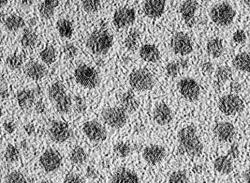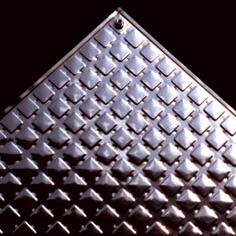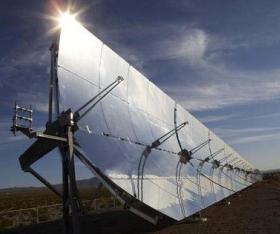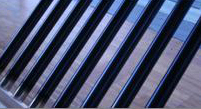Highly durable selective solar absorber coatings for solar thermal collectors and electricity generation by concentrated solar power (CSP)
Contact: Andreas Schueler
Thermal solar collectors exhibit high energy conversion efficiencies and short energy pay back times. A temperature of 80°C is a commonly achieved by thermal solar collectors. According to the Stefan-Boltzmann law, a black body would emit under these conditions some 900 W/m2, which is already in the order of the incident solar energy at ground level. The ideal behavior of an absorber surface is a high absorptance in the solar spectral region and a low emittance in the range of thermal radiation, which implies a step-like reflectance spectrum with R = 0 in the solar region and R = 1 in the infrared range. A surface approaching this property is called optical selective. In addition to these optical requirements, a solar absorber coating has to withstand elevated temperatures and humidity inside the collector during a lifetime in the order of 25 years.
Advanced nanocomposite coatings are developed for glazed collectors aiming at high optical performance and superior aging stability. Promising novel highly durable materials are titanium containing amorphous hydrogenated silicon carbide films (a-Si:C:H/Ti) produced by a vacuum plasma process, and nanocomposite ceramic coatings of the spinel type produced by low-cost sol‑gel dip-coating. Both materials are interesting alternatives to the traditional black chrome coating, which is still in use today, and whose production is based on a highly toxic Cr(VI) precursor.
A chromium-free black selective coating for durable selective solar thermal absorbers has been developed in the framework of Dr Martin Joly’s PhD thesis. As compared to the most durable solar absorber coatings today, the novel black selective nanocomposite coating has the advantage of a highly superior stability at elevated temperatures in air, combined with an improved corrosion resistance. Its remarkable properties make the novel nanocomposite coating especially interesting for solar thermal electricity generation in large-scale solar power plants.



Metallic clusters: Selective solar absorber coatings

Patent WO 2014045241 A2, published 27.3.2014 (Industrial partner Zettl GmbH, Munich, Germany) Method for hardening a coating of a solar collector element, and elements produced by means of said method
PhD thesis in this domain
EPFL PhD thesis 5541, Martin Joly, 2012: Développement et optimisation de revêtements nanostructurés pour capteurs solaires thermiques et modules photovoltaïques
Publications
Joly, M., Bouvard, O., Gascou, T., Antonetti, Y., Python, M., González Lazo, M.A., Loesch, P., Hessler-Wyser, A., Schüler, A., Optical and structural analysis of sol-gel derived Cu-Co-Mn-Si oxides for black selective solar nanocomposite multilayered coatings, (2015) Solar Energy Materials and Solar Cells, 143, pp. 573-580. DOI: 10.1016/j.solmat.2015.06.058
Joly, Y. Antonetti, M. Python, M. Gonzalez, T. Gascou, J.-L. Scartezzini, A. Schüler, Novel black selective coating for tubular solar absorbers based on a sol–gel method, Solar Energy 94 (2013) 233–239
DOI: 10.1016/j.solener.2013.05.009
P. Oelhafen, A. Schüler, Nanostructured Materials for Solar Energy Conversion, Solar Energy 79, 110 (2005) DOI: 10.1016/j.solener.2004.11.004